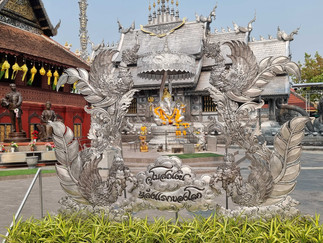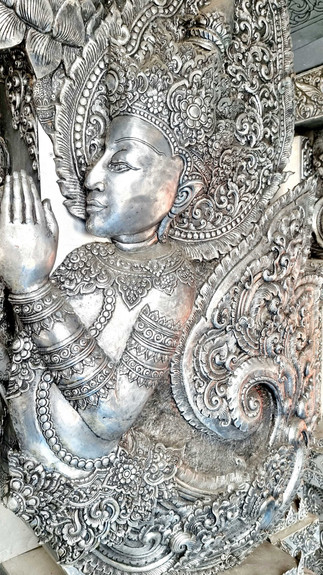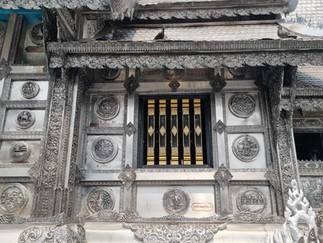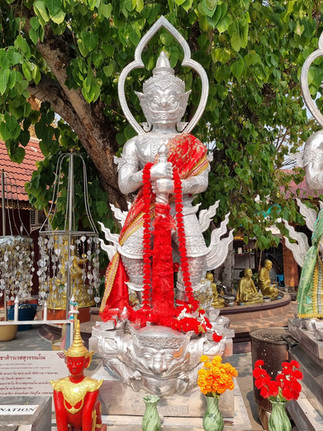Wat Sri Suphan - The Silver Temple
- Shannon
- Oct 1
- 4 min read
Chiang Mai’s Shimmering Silver Masterpiece
Located among the narrow, winding lanes just south of Chiang Mai’s historic South Gate, Wat Sri Suphan stands as the dazzling centerpiece of the Haiya subdistrict, a historic residential area renowned for its traditional silver workshops. An inscription within the temple grounds reveals that the complex was originally built in 1501 during the reign of King Mueang Kaeo, the 11th ruler of the Lanna Kingdom’s Mangrai Dynasty.

Adorning the entrance to the ubosot are a pair of kinnari, half-human, half-bird beings who protect devotees
During the past 500 years, the Wat has been has been consecrated and renovated numerous times, leaving only faint traces of its original structure. However, the foundation and eight sema stones, marking the sacred boundary of the ordination hall, have been preserved. In December 1941, Japanese soldiers commandeered the temple, forcing resident monks to evacuate as it became a military base during World War II.
In 2008, a group of skilled local artisans began a eight-year journey to to embellish and transform the sacred shrine with exquisite silver repoussé work. The process involved intricate detailing, with most of the designs crafted from aluminum, nickel or zinc alloys. Precious silver was carefully reserved for the most revered images found within the inner sanctuary, adding a layer of reverence and significance to the heart of the temple.

This three dimensional art piece, a modern interpretation of traditional Lanna design, beautifully blends elements of both Mahayana and Theravada Buddhism. Intricate exterior carvings depict religious mythology, the Thai Zodiac, rural life and stories from the Jātaka tales, which recount the Buddha’s many lives before reaching enlightenment. Inside contains the golden Phra Jao Jed Tue state of Buddha, believed to be at least five centuries old.
Beneath the foundation of the original Ordination Hall, numerous sacred objects, amulets and incantations were buried over 500 years ago as part of a ritual to consecrate the temple. These items were uncovered during the restoration project, offering a fascinating glimpse into the spiritual practices of the past. The discovery added even greater significance to the site, connecting the present temple with its ancient, revered history.

The ancient monastery grounds are also home to a Grand Viharn (prayer hall), built around 200 years ago by the 6th prince of Chiang Mai. The main entrance is flanked by an imposing pair of Nagas, while the interior murals vividly depict the stories of the Buddha’s life. Adjacent to the viharn, a Sala Pavilion and workshop serve as a hub for master silversmiths, who pass down their centuries-old knowledge and expertise in fine metalwork to the next generation.
In Thai artistic and cultural tradition, silver is often associated with refinement, purity and craftsmanship. It plays an important role in religious and ceremonial contexts, particularly in northern Thailand where silverwork has been elevated to a spiritual art form. At Wat Sri Suphan, silver is not only a material for decoration but also a medium for preserving sacred narratives and honouring local beliefs. This contrasts with gold, which is more commonly associated with divinity and merit-making in central Thai temples.
The central finial has seven gilt umbrellas, which symbolise the universe
According to Lanna belief, women are not permitted to enter the Ubosotha (ordination hall) at Wat Sri Suphan due to its sacred nature. The Ubosotha is considered a highly spiritual space reserved for male monks, and entering it is thought to potentially disrupt its purity or harm the woman herself. This tradition reflects broader cultural and religious practices within the Lanna Kingdom, where the presence of women in such a sacred space is believed to disturb the energy and rituals focused on male monastic practices. While some temples have evolved in their approach, Wat Sri Suphan continues to honour this traditional belief.
On the rear wall, this intricate and beautifully designed mural tells the story of an important event in Buddhist lore
🗺️ Location
100 Wua Lai Road, Tambon Hai Ya, Amphoe Mueang, Chiang Mai Province
🚆 How to get there
If you're staying within the Old City, the temple is a 25 minute walk south. Head towards the Chiang Mai Gate, then continue straight onto Wua Lai Road. The temple is located just beyond the Saturday Walking Street Market. Alterntively you can grab a 10 minute Songthaew for around 25THB or negotiate a TukTuk for about 100 THB.
⭐ Attraction Info
Wat Sri Suphan - The Silver Temple is open everyday between 6am - 9pm, for a small entry fee of 50 THB. Visitors must dress modestly, covering the shoulders and the knees. The best time to visit is in the early morning or late afternoon when the light is the best for photos. The temple monks provide visitors the opportunity for a "monk chat". This unique opportunity allows travellers to learn about monastic life and engage in a mindful exchange with someone who has dedicated their life to Buddhism. These are held at 5:30pm every Tuesday, Thursday and Saturday. They also offer meditations at 7pm on the same days.
วัดศรีสุพรรณ
Thanks for reading about Wat Sri Suphan - The Silver Temple. Check out more awesome destinations here!




































